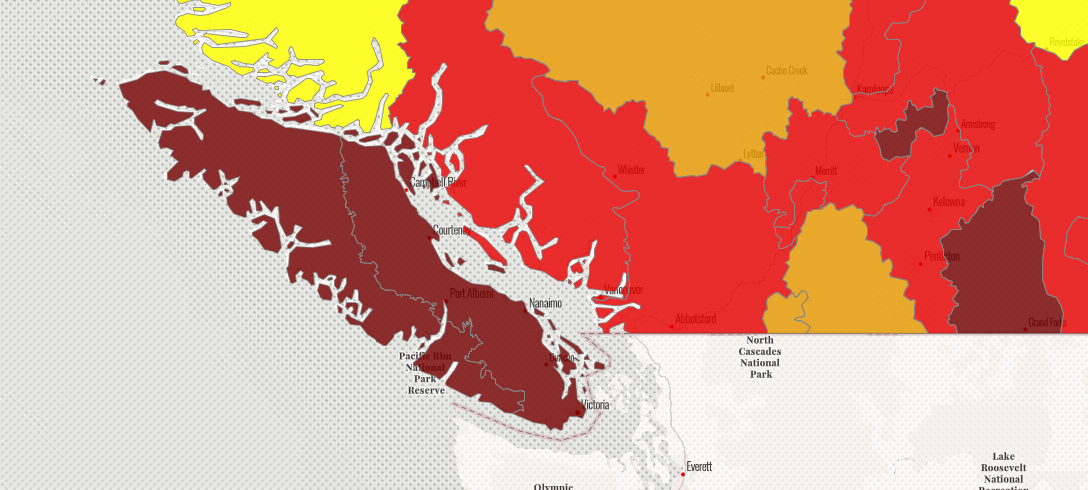Cooler temperatures aren’t bringing the rain we so desperately need.
Concerns about water supply security, drought, and water scarcity remain an issue for most of the southern half of B.C.
Unsettled weather bringing periods of rain to the northern and far eastern regions of the province, producing increased flows and alleviating threatening drought conditions.
Such is not the case Vancouver Island, the entire of which is under Level 5 drought conditions.
The drought level system ranges from level 0 to 5 in B.C.
Level 5 is the most severe, with adverse impacts to socioeconomic or ecosystem values almost certain.
There are currently four basins at Drought Level 5, including the Kettle River watershed, the Salmon River watershed, West Vancouver Island and East Vancouver Island.
To preserve water, most of the Comox Valley moved to Stage 3 water restrictions on Aug. 16th.
The restrictions include Comox, Courtenay, and the Comox Valley Water Local Service Area.
During Stage 3 water restrictions, residential lawn and garden watering with a sprinkler is not allowed at any time.
Meanwhile, Campbell River remains in Stage 2.
That means residential watering is only allowed during certain hours of the day on Mondays for even-numbered addresses, and on Thursdays for odd-numbered addresses.
Smaller watersheds in the Thompson Okanagan region are also showing signs of being at a Drought Level 5.
However, the dry conditions and water scarcity in the southwest Interior continue to intensify as rain is predicted to bypass these areas.
The forecast slightly above-normal temperatures leading into early September will likely influence drought conditions, as well, according to the province.
Many freshwater angling closures are in place throughout B.C. due to increased stress to fish from low flows and high water temperatures.
People in those areas impacted by severe drought are being asked to reduce their water use wherever possible and follow all watering restrictions from their local/regional government, water utility provider, or irrigation district.
Voluntary reduction of water usage has proven to be an effective way to offset the need for regulatory action on the Coldwater River and Louis Creek, reinforcing the importance and benefits of conservation. Voluntary reduction of surface and groundwater continues to be highly encouraged for water users in southern B.C.
If conservation measures do not achieve sufficient results and drought conditions worsen, regulatory action will continue to be taken under the Water Sustainability Act.
This includes temporary protection orders issued to water licensees to avoid significant or irreversible harm to the aquatic ecosystems.
As of Aug. 30, 2021, temporary protection orders have been issued for the Koksilah River, West Kettle, Bessette Creek and the Salmon River. Provincial staff are monitoring the situation, as well as the protection orders that are in place, and will continue to work to balance water uses with environmental flow needs. The B.C. government recognizes the distress that regulatory action can have on the livelihoods of British Columbians and ensures that regulatory staff are prepared to adjust or rescind orders if conditions change.
Areas under Drought Level 4 as of Aug. 25, 2021, include:
- the North and South Thompson basins, the Okanagan basin, as well as the Coldwater River and Nicola River watersheds in the Thompson Okanagan region;
- the Lower Columbia and West Kootenay basins; and
- the Lower Mainland and South Coast basins.
In these areas, adverse effects of drought on people, fish or ecosystems are likely.
Regions under Drought Level 3 include the Similkameen, Cariboo/Chilcotin and Skagit watershed.
Of note, several local streams in the Similkameen and Cariboo/Chilcotin areas are experiencing greater impacts.
Eleven other watershed basins in B.C. are either under Drought Level 2 or Drought Level 1.
General water conservation tips:
At home:
- Limit outdoor watering.
- Do not water during the heat of the day or when it is windy.
- Consider planting drought-tolerant vegetation.
- Take shorter showers.
- Do not leave taps running.
- Install water-efficient showerheads, taps and toilets.
On the farm:
- Implement an irrigation scheduling program using real-time weather data.
- Schedule irrigation to match crop needs and soil storage capacity.
- Improve water system efficiencies and check for leaks.
- Focus on high-value crops and livestock.




